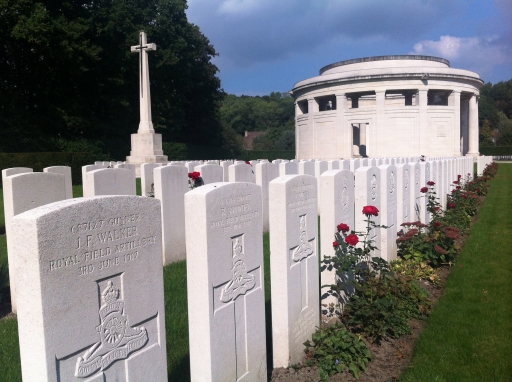A new interpretation centre looks to guide visitors around the Ploegsteert area of Belgium, reports Centenary News’ Dan Hayes.
An interpretation centre is scheduled to open near Ploegsteert in Belgium this November.
Entitled the Plugstreet 14-18 Experience, after the British troops’ version of the village’s Flemish name, the centre will explain the role the area and its surrounding region played in the First World War and aims to give visitors the information they need to get the most from a visit to the nearby battlefields.
Anny Beauprez, president of the tourist office of the Commines-Warneton area, which includes Ploegsteert, says: ‘The architect designed the centre to comprise a pyramid-shaped roof above a main display area that is largely underground and reached by a sloping walkway.
‘The pyramid evokes Hill 63, which was a distinctive feature of this part of the front, while the subterranean aspect brings into mind the catacombs nearby that were dug by Australian troops prior to the offensive of 1917.’
‘An interpretation centre, not a museum’
The centre will be divided into five main sections, each of which will focus on the soldiers and civilians who lived and died in the Ploegsteert area between 1914 and 1918. Films, photographs and maps will all be used to tell the tale.
‘There will also be an interactive section that deals specifically with the Australian troops who were based here, especially the Australian Tunneling Companies that worked in this area prior to the Battle of Messines in 1917,’ says Beauprez.
‘It’s important to remember that his is an interpretation centre, not a museum,’ she adds. ‘We want to inspire people to go out and see the landscape for themselves. If somebody spends an hour here I think they’ll know enough about the area to understand what happened here in the First World War.’
The Tourist Office is also working on involving local schools in the project before and after the Centenary. ‘One idea we’re looking at is to get school children to adopt the grave of one of the soldiers who is buried in the area,’ Beauprez says.
Ploegsteert had a varied First World War history. It was near here that the cartoonist Bruce Bairnsfather famously witnessed fraternization between British and German troops at Christmas 1914.

Bairnsfather, a second lieutenant in the Royal Warwickshire regiment who went on to create the archytypal cartoon Tommy, Ol’ Bill, wrote at the time: ‘There was not an atom of hatred on either side that day, and yet, on our side, not for a moment was the will to war and the will to beat them relaxed. It was just like the interval between the rounds of a friendly boxing match.’
Near the building where Bairnsfather was billeted, a wooden cross, erected by historical group The Khaki Chums, marks the site of one of the football games that was played between British and German soldiers in 1914.
In the early years of the war, Ploegstreet was seen as a fairly quiet area. Following the Gallipoli campaign, Winston Churchill was based nearby – between January and May 1916 – as commanding officer of the 6th Battalion, Royal Scots Fusiliers. While at the time this was publicised as the statesman taking his chances on the front line, many of the Tommies knew the risks in this sector were somewhat less than those in most other places.
Later in the war, however, that was not the case. Close to Ploegsteert is the Messines Ridge, site of fierce fighting in June 1917, and Mount Kemmel, scene of much loss of life in 1918.
Memorial to the Missing
Many of the British and Commonwealth soldiers who fell in those battles are commemorated on the Ploegsteert Memorial to the Missing. This columned, white marble monument is inscribed with the names of 11,447 soldiers who have no known grave.
Even today, items are occasionally discovered in the area that lead to one of those missing men being identified. The most recent incident of this kind occurred in 2008, when the remains of a soldier were discovered near the remains of a mine explosion known as the Ultimo Crater.
After extensive research, archeologists were able to identify the man as 37-year-old private Alan Mather of the 33rd Battalion, Australian infantry, who was reported missing on 8 June 1917. He was from Inverell, New South Wales, and was buried at Prowse Point Military CWGC cemetery in July 2010.
Also identified in recent years were two soldiers of the 2nd Battalion, Lancashire Fusiliers, privates Richard Lancaster and Harry Wilkinson, whose remains were recovered in 2006 and 2000 respectively. Both soldiers were killed on 10 November 1914 during an attack on German-held trenches at Ploegsteert Wood and are now also interred at Prowse Point.
Private Lancaster was a 32-year-old former weaver from Burnley who was a father of four, while 29-year-old Private Wilkinson worked as a boiler operator in a cotton mill in Bury and had left behind his pregnant wife and six-year old son when he sailed to France in August 1914. Both were former professional soldiers who had been recalled to the army at the outbreak of hostilities.
Stories such as these will be typical of those that feature at the Plugstreet 14-18 centre when it opens, helping to provide visitors with an understanding of the human impact of the First World War and its lasting effects.
© Centenary Digital Ltd & Author
